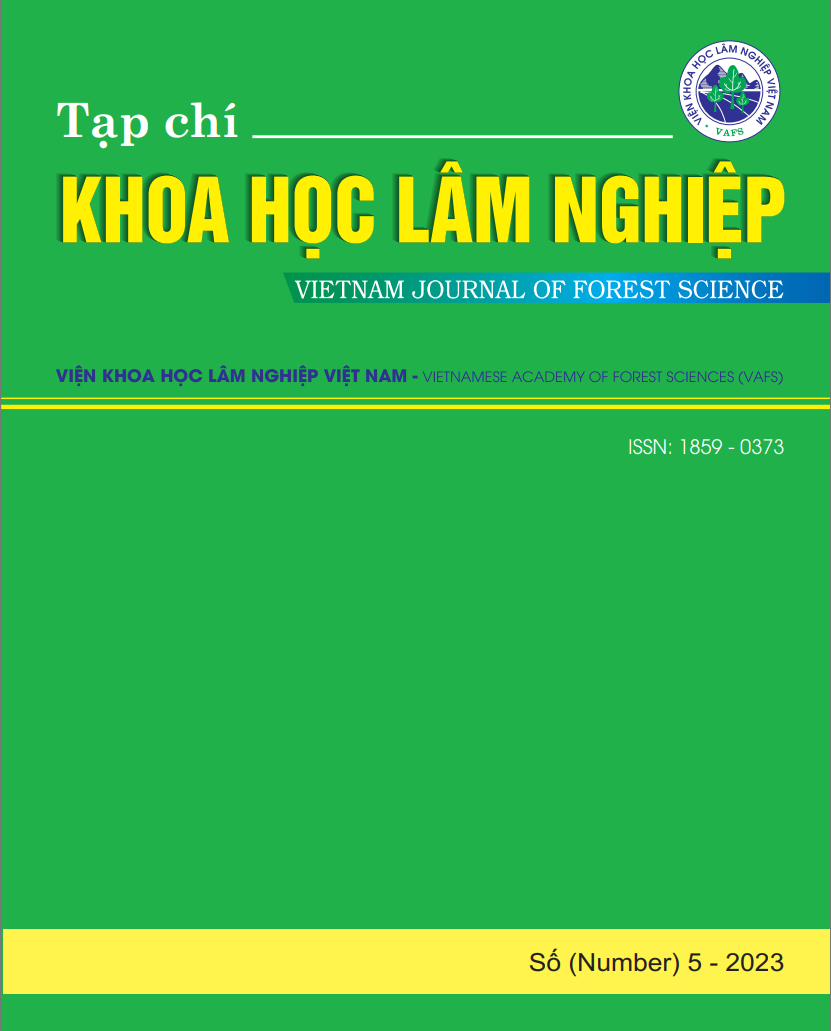DESIGN OF AN INDUSTRIAL-SCALE WOOD DRYING SYSTEM USING SOLAR ENERGY INTEGRATED WITH SATURATED STEAM
DOI:
https://doi.org/10.70169/VJFS.1193Keywords:
Acacia hybrid wood drying, drying system design, energy - efficient drying, solar energy, solar - steam hybrid kiln, thermal balanceAbstract
Wood drying is the most energy-intensive stage in wood processing, accounting for approximately 60 - 70% of the total energy consumption. Conventional drying systems typically rely on biomass or fossil - fuel - fired boilers, leading to high operational costs and significant emissions. Meanwhile, fully solar - based wood drying systems often lack stability, are weather - dependent, and are difficult to implement on an industrial scale. This study presents the design, calculation, and experimental evaluation of an industrial - scale solar - steam hybrid wood drying system with a capacity of 100 m³ per batch for acacia hybrid lumber. The research methodology is based on thermal, mass, and aerodynamic balance analyses to determine key technical parameters, aiming to maintain a stable drying temperature of 50 - 60 °C and to optimize a triple - layer dome structure comprising a transparent insulation layer, a hot - air channel, and a solar - absorbing surface. The total energy demand for one drying batch was estimated at approximately 98,1 GJ (equivalent to 56,8 kW). The system was designed with a solar collector area of ≥ 230 m², a steam boiler with a minimum capacity of 100 kg/h (at 4 bar), a heat exchanger area of ≥ 23 m², and ten circulation fans with a total power of ≥ 22 kW. Experimental results demonstrated that the system operated stably within the target temperature range, achieving a 35 - 40% energy saving compared with conventional steam drying kilns. These findings confirm the technical feasibility and practical potential of the proposed solar - steam hybrid system for industrial wood drying applications.
References
1. Bektas, I., & Bektas, C. (2005). Fundamental aspects of kiln drying lumber (FAPC-151). Oklahoma State University Extension.
2. Bureau International des Poids et Mesures (BIPM). (2019). The International System of Units (SI Brochure) (9th ed.). Paris: BIPM.
3. Boone, R. S., Wengert, E. M., & Denig, J. (1999). Drying hardwood lumber (Gen. Tech. Rep. FPL-GTR-118). USDA Forest Products Laboratory.
4. Çengel, Y. A., & Boles, M. A. (2019). Thermodynamics: An engineering approach (9th ed.). McGraw-Hill Education.
5. Chen, Q., Zhou, X., & Xu, Z. (2022). Techno-economic analysis of a solar-assisted heat pump drying system for industrial applications. Applied Thermal Engineering, 205, 118015.
6. Denig, J., Wengert, E. M., & Simpson, W. T. (2000). Drying hardwood lumber (FPL-GTR-118). U.S. Department of Agriculture, Forest Service. DOI: 10.2737/FPL-GTR-118
7. Duffie, J. A., & Beckman, W. A. (2013). Solar engineering of thermal processes (4th ed.). John Wiley & Sons. DOI: 10.1002/9781118671603
8. El-Sebaii, A. A., & Shalaby, S. M. (2021). Thermal performance of a solar dryer with a thermal energy storage system: A comprehensive review. Renewable and Sustainable Energy Reviews, 149, 111394.
9. Ferrari, S., Cuccui, I., Cerutti, P., & Allegretti, O. (2024). A hybrid solar/biomass active indirect kiln dryer for timber in the Democratic Republic of Congo. International Journal of Ambient Energy, 45(1), Article 2367109. DOI: 10.1080/01430750.2024.2367109
10. Intergovernmental Panel on Climate Change (IPCC). (2006). 2006 IPCC guidelines for national greenhouse gas inventories.
11. Intergovernmental Panel on Climate Change (IPCC). (2019). 2019 refinement to the 2006 IPCC guidelines for national greenhouse gas inventories.
12. ISO. (1992). ISO 31-4:1992 – Quantities and units – Part 4: Heat. Geneva: ISO.
13. Lamrani, B., Draoui, A., & Kuznik, F. (2021a). Thermal performance and environmental assessment of a hybrid solar–electrical wood dryer integrated with photovoltaic/thermal air collector and heat recovery. Solar Energy, 221, 60–74.
14. Lamrani, B., Kuznik, F., Ajbar, A., & Boumaza, M. (2021b). Energy analysis and economic feasibility of wood dryers integrated with heat recovery unit and solar air heaters. Energy, 228, 120598.
15. Luna, L. M., Allegretti, O., Cerutti, P., & Cuccui, I. (2018). Performance evaluation of a solar timber kiln: A case study. Energy for Sustainable Development, 44, 58–66.
16. Ministry of Natural Resources and Environment (MONRE). (2022). National GHG inventory and emission factors of Vietnam. Hanoi: MONRE.
17. Ndukwu, M. C., Abesinghe, A., & Uzoejinwa, B. B. (2020). Solar drying of food and agricultural products: A critical review. Renewable and Sustainable Energy Reviews, 124, 109787.
18. Ngọc, B. D. (2022). Thiết kế chế tạo hệ thống thiết bị sấy gỗ xẻ rừng trồng bằng năng lượng mặt trời. Tạp chí Khoa học Lâm nghiệp, (1), 112–119.
19. Nguyễn Xuân Trung, & Đinh Vương Hùng. (2014). Thiết bị sấy nông sản bằng năng lượng mặt trời tại Việt Nam. Tạp chí Khoa học và Phát triển, 12(8), 1148–1156.
20. TCVN 13706:2023. Gỗ sấy – Phân hạng theo mức chênh lệch độ ẩm.
21. TCVN 2737:2023. Tải trọng và tác động – Tiêu chuẩn thiết kế.
22. TCVN 8929:2013 (ISO 4474:1989). Gỗ khúc cây lá kim và cây lá rộng để xẻ – Khuyết tật nhìn thấy được – Thuật ngữ và định nghĩa.
23. TCVN 8930:2013 (ISO 4473:1988). Gỗ khúc cây lá kim và cây lá rộng để xẻ – Khuyết tật nhìn thấy được – Phân loại.
24. World Bank, & Energy Sector Management Assistance Program (ESMAP). (2019). Global Solar Atlas 2.0: Technical report. Washington, DC: World Bank.









